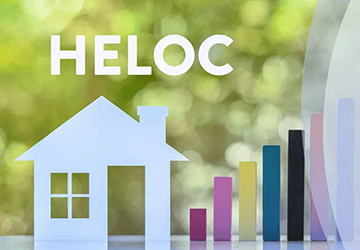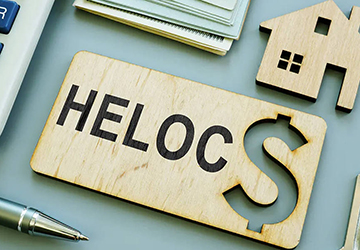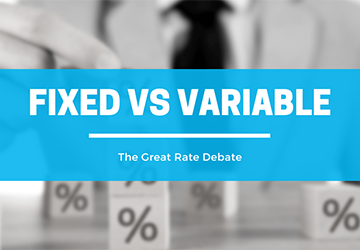Mastering the Art of Utilizing a Home Equity Line of Credit (HELOC) WiselyHere's
A Home Equity Line of Credit (HELOC) unlocks the value stored in your physical possession and gives you access to a line of credit that can be used for various purposes. But just like deploying Excalibur, deploying a HELOC also requires responsibility. If used wisely, it can be financially vital. If misused, it can get you in trouble.

This blog will guide you on effectively using a HELOC for home improvement projects. We'll explain in detail how it works, explore intelligent ways to use it, and reveal pitfalls to avoid.
Understanding HELOCs
Over time, homeowners tend to accumulate significant equity in their homes. This equity represents the portion of your home that you own – the market value minus any outstanding mortgage debt. A Home Equity Line of Credit (HELOC) allows you to tap into this accumulated value and obtain a line of credit that can be used for various purposes. But before you dive in, it's essential to understand the mechanics and workings of a HELOC.
An Explanation of the Most Important Terms
● Equity is your ownership interest in your home. It is the current market value of your home minus your outstanding mortgage balance.
● Line of Credit: You will be approved for a certain maximum amount (the credit line). All you have to do is borrow money and pay interest on the funds you draw down.
● Payment Period: This is your credit period. During this period (usually lasting 5 to 10 years), you can draw funds from your line of credit for various expenses.
● Repayment Period: After the repayment period ends, the repayment phase begins. You typically have 15 to 20 years to repay the borrowed amount and any accrued interest.
● Interest Rate: HELOCs typically have variable interest rates based on market conditions. While generally lower than credit card rates, they are still higher than fixed-rate mortgages.
Creative Ways to Use a HELOC
Here is a detailed breakdown of some creative ways to tap into your home equity for a better financial future while keeping in mind important HELOC financial planning tips:
Home Improvements
Using a HELOC for home improvements can be strategic if done correctly. Focus on projects that will increase the value of your home, such as B. Kitchen renovations, bathroom modernizations, or a new roof. These improvements will improve your living space and enjoyment of your home and increase your home's market value, which translates into more equity; this creates a win-win situation—a more comfortable and potentially more valuable home.
HELOC Financial Planning Tip: Consider your home improvement project's ROI (return on investment). Aim for a project to recoup most of the cost when you sell your home.
Another benefit for tax-conscious homeowners: Depending on current tax laws and the funds used, the interest paid on a HELOC may be tax-deductible (check with a tax advisor to see if you qualify). This can increase the financial benefits of using a HELOC to make smart home improvements.
Debt Consolidation
Are you drowning in high-interest debt from credit cards or other loans? A HELOC can be a lifeline for debt consolidation. You can consolidate your debt into a single HELOC with a lower interest rate; this simplifies your repayment process because you only have to make one monthly payment instead of juggling multiple debts at once. Plus, the lower interest rate on a HELOC can save you money on interest in the long run. Remember, a HELOC is still a loan. So, ensure you have a solid repayment plan to stay out of debt.
HELOC Financial Planning Tips: Before consolidating debt with a HELOC, compare the interest rates and terms with other consolidation options, such as B. Personal loans or balance transfer credit cards. Choose the option with the lowest overall cost and terms that fit your budget.
Emergency Safety Net
Life always has surprises, and a HELOC can be a financial safety net for unexpected expenses like medical bills or major car repairs. However, use a HELOC in an emergency only as a last resort after your savings or other emergency funds have been exhausted.
HELOC Financial Planning Tips: Build a solid emergency fund to cover unexpected expenses. Aim to save 3-6 months of living expenses by minimizing your reliance on a HELOC in an emergency.
Training Expenses
While a HELOC isn't the first option you should consider, it can help you pay for college for yourself or your children. However, this decision should be carefully considered and made with HELOC financial planning first. Before tapping into your home equity, look into scholarships, grants, and traditional student loans with lower interest rates. These options often offer more favourable repayment terms and don't put your home at risk. Remember, your home is equipped with a HELOC, so it's crucial to use it responsibly.

HELOC Financial Planning Tip: If you use a HELOC to pay for college, borrow only the funds you need and have a clear repayment plan after graduation.
HELOCs - What to Avoid
Now that you've learned about the creative uses of HELOCs, here are some things you should avoid:
1. Daily Living Expenses
A HELOC is not a magical ATM for everyday expenses. Think of it as a lifeline for emergencies or strategic investments, not a bottomless pit for food or fun. If you use a HELOC to pay for everyday expenses, you may quickly fall into a cycle of debt. Remember, a HELOC is a loan; every purchase you make adds to your repayment burden.
2. Luxury Purchases
It may be tempting to finance your dream vacation or brand-new car with a HELOC, but resist the temptation! HELOCs are not meant to finance non-essential, depreciating items. When you drive it off the lot, the car loses value, and the vacation memories fade, but the HELOC debt remains.
3. Risky Investments
While HELOCs can be used for investing, using your home equity to enter the realm of speculation is a losing gamble. The real estate market can fluctuate, and if your investments go wrong, you could lose your home—the asset secured by your HELOC.
Wrapping Up
HELOCs can be a game changer but should be used strategically and responsibly. Contact a financial advisor if you need help deciding if a HELOC suits you. You can guarantee that your HELOC journey will lead you to financial freedom, not financial hardship.





